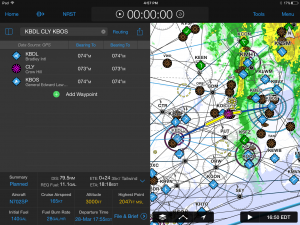
Like all electronic flight bag apps, Garmin Pilot has a lot of powerful features built in. But if you haven’t spent the time to tap every button and try every menu, you probably haven’t had a chance to use them all yet. Here are 6 hidden tricks to check out the next time you use the Garmin Pilot app.
1) Alternate Selection Guide – To help IFR pilots with the task of finding a suitable alternate airport during flight planning, Garmin Pilot includes a useful too called the Alternate Airport Selection Guide. To use this, first enter a new route in the Trip Planning section of the app. If the forecast ceiling or visibility dictates that an alternate airport will be required, the app will display a yellow triangle next to the flight plan in the list.
This is your cue to scroll down further on the Trip Planning page, where you’ll see Alternate Destination highlighted with a yellow border. Tap the “Alternate Selection Guide” just above it to view a list of nearby airports, along with the ceiling and visibility forecast for your ETA. There are also quick links next to each airport to view the specific alternate minimums for that airport.
2.) Decoded PIREPs – PIREPs are displayed as color-coded symbols on the Maps page, allowing you to quickly view type and intensity at a glance. You can also view a fully-decoded version of the PIREP by tapping on it, and then the PIREP symbol in the menu circle.
3) Nearest Airport Criteria – Garmin’s nearest airport function is by far the best of any EFB app on the market. To make it even more useful, go to the General Settings page, and and find the Nearest Airport Criteria settings. This allows you to specify a minimum runway length and surface type for the nearest airports page.
4) Minimum altitude warning – When in the Flight Plan section of the app, Garmin Pilot provides a subtle alert if your planned altitude doesn’t provide enough clearance above the highest terrain feature or obstacle along your route. When a conflict is detected, both the planned altitude and highest point will be colored yellow or red, and the conflicting part of the route will be highlighted in yellow or red on the map.
5) Import previous logbook entries – Garmin provides a powerful digital logbook integrated right in the app, which can be used to automatically log your flights. One of the big challenges with using a new logbook program though is importing previous flight times. Fortunately Garmin provides a web-based solution to accomplish this.
First log into your Garmin account at flygarmin.com, select the Logbook tab at the top of the screen, and select Import from the list of options. You’ll see downloadable templates for both Microsoft Excel and Apple Numbers spreadsheet programs to help you get your data in line, along with the option to upload the spreadsheet on the same page. This will then sync up automatically with the logbook in the app.
6) Location-based alerts – In addition to setting time-based alerts (useful for reminding you when to switch fuel tanks), you can also set alerts to trigger when reaching a certain location along your route. To set an alert, tap the Tools button at the top of the screen, and select Alerts. Now select Location as the type of alert, and choose the waypoint you’d like to be alerted at. For example you could use this to help remind yourself to close the flight plan after landing at the destination airport.
Source: Ipad apps6 hidden tricks in the Garmin Pilot app





